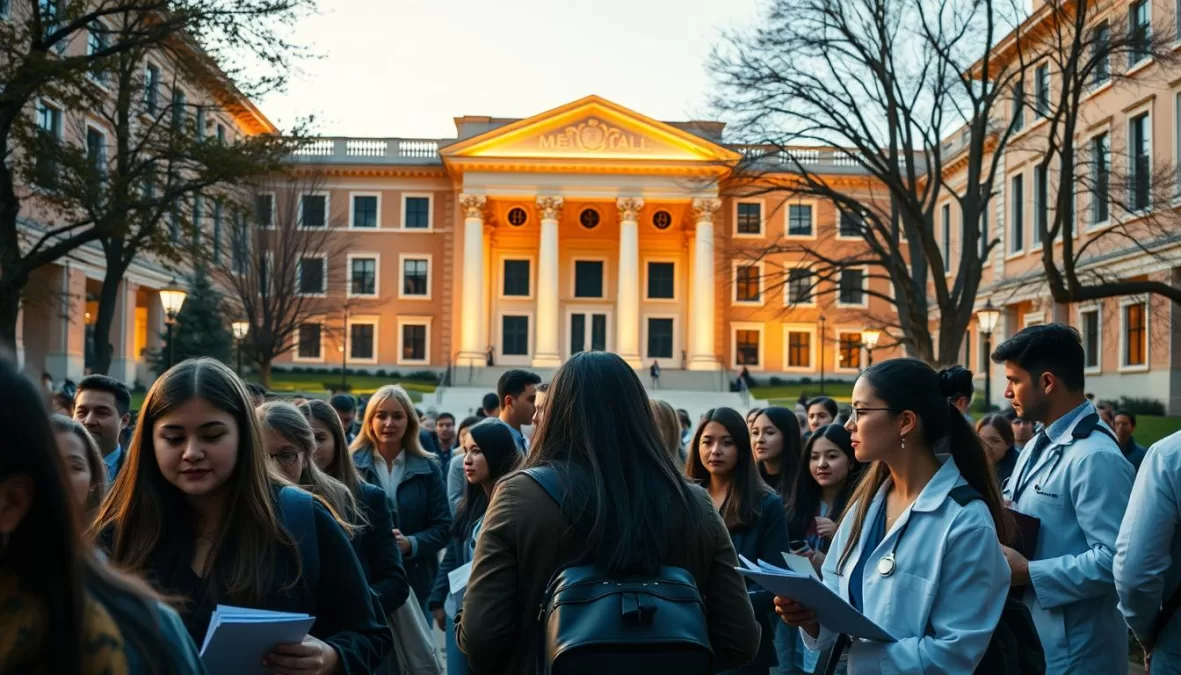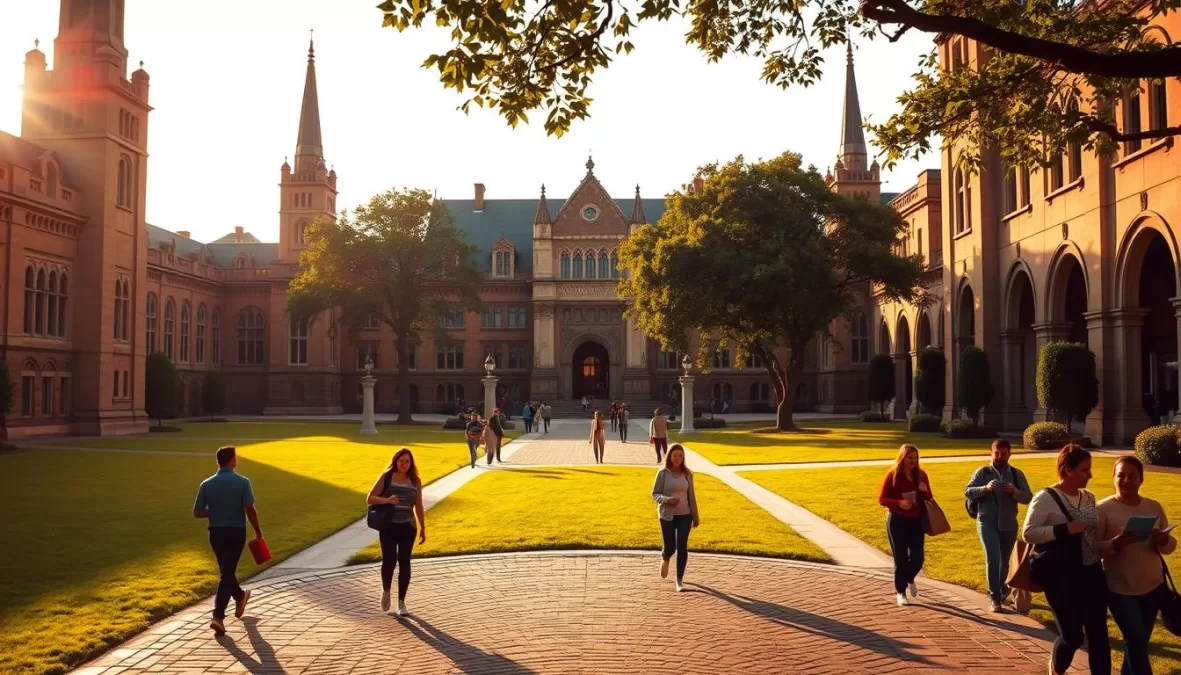Choosing the right institution for your studies in medical sciences is a big decision. With over 700 recognized institutions, India offers a wide range of options. Whether you aim for affordability or prestige, understanding rankings and fees can help you make an informed choice.
Government-funded schools, like AIIMS Delhi, provide high-quality education at minimal costs—around ₹10,000 annually. Private institutions, however, may charge up to ₹25 lakhs per year. The NIRF rankings highlight top performers, with AIIMS leading at 94.46 points.
Admission depends on your NEET UG score, so preparation is key. Researching college research facilities, faculty, and placement records will ensure you pick the right fit for your career goals.
Key Takeaways
- India has 706 NMC-recognized institutions for medical sciences.
- AIIMS Delhi ranks #1 in NIRF 2024 with a score of 94.46.
- Government colleges charge as low as ₹7,000 per year.
- Private institutions may cost up to ₹25 lakhs annually.
- NEET UG scores determine admission eligibility.
Introduction to the Best Medical Colleges in India
With over 20 lakh NEET applicants yearly, competition is fierce. Only 740+ institutions accept these scores, making your choice critical. A degree from an MCI/UGC-accredited school ensures global recognition and better career prospects.
Why Choosing the Right Medical College Matters
Top-tier institutions retain 89% of students through graduation, compared to 62% elsewhere. This gap reflects differences in teaching quality and resources. Modern facilities like simulation labs and 1000-bed teaching hospitals directly impact your clinical skills.
The FMGE pass rate was just 16% in 2024. Graduates from accredited government medical college programs typically outperform peers. Your training location affects not just knowledge but licensing success.
Key Factors to Consider When Selecting a Medical College
Faculty ratios reveal attention you’ll receive. AIIMS maintains a 1:8 teacher-student ratio, while the national average is 1:15. More interaction means better mentorship for medical education research projects.
Verify these essentials before applying:
- MCI/UGC accreditation status
- Number of hospital beds for practical training
- Placement records for postgraduate institute medical programs
- FMGE pass percentages
Remember, 69 institutions faced allegations of substandard education last year. Always cross-check claims with official NMC reports.
Best Medical Colleges India: NIRF Rankings 2024
India’s NIRF rankings highlight excellence in teaching and research. These rankings help you compare institute medical sciences objectively. Over 10,885 institutions participated in 2024, but only a few scored above 70.
Top 5 Institutions as per NIRF
AIIMS Delhi leads with a 94.46 score, excelling in all parameters. PGIMER Chandigarh follows at 80.83, renowned for its college hospital and research output. Here’s the full list:
- AIIMS Delhi: 94.46 (TLR: 28.34, RPC: 28.34)
- PGIMER Chandigarh: 80.83 (1,200+ annual publications)
- CMC Vellore: 75.11 (1,900+ clinical trials since 2000)
- NIMHANS Bangalore: 71.92 (Specialized neurosciences focus)
- JIPMER: 70.74 (89% graduate retention rate)
How NIRF Rankings Are Determined
NIRF evaluates india institute performance across five pillars:
- Teaching & Resources (30%)
- Research & Practices (30%)
- Graduation Outcomes (20%)
- Outreach (10%)
- Perception (10%)
For example, CMC Vellore’s high RPC score reflects its legacy in trials. JIPMER’s 89% retention boosts its Graduation Outcomes. Always check these metrics to find programs aligned with your goals.
Careers360 Ranking of Top Medical Colleges
Careers360 offers a fresh perspective on evaluating excellence in healthcare education. Unlike NIRF, it prioritizes student experiences and medical education research impact. This helps you gauge institutions beyond traditional metrics.
Top Performers in Careers360’s 2024 List
AIIMS Delhi leads with a 4.9/5 student satisfaction score. CMC Vellore follows, boasting 125 global collaborations. Kasturba Medical College (KMC) Manipal ranks third with a 98% internship placement rate.
Here’s why these schools stand out:
- AIIMS Delhi: Near-perfect faculty-student interaction scores.
- CMC Vellore: Pioneering clinical trials since 2000.
- KMC Manipal: Part of Manipal Academy Higher Education (MAHE), leveraging its 67.42 NIRF score for infrastructure upgrades.
How Careers360 Measures Excellence
Their methodology focuses on:
- Academic Productivity (35%): Curriculum rigor and faculty publications.
- Student Quality (25%): NEET scores and graduation rates.
- Research (20%): Grants and patent filings.
NIRF emphasizes institutional resources, while Careers360 values outcomes like placements. Use both to find programs matching your goals.
Placement-Wise Top Medical Colleges in India
Your career prospects after graduation depend heavily on where you study. Institutions like PGIMER Chandigarh and VMMC Delhi dominate placement rankings, offering direct pathways to prestigious roles. Let’s explore which schools deliver the strongest job outcomes.
Colleges with the Highest Placement Ratings
PGIMER Chandigarh boasts a 4.9/5 placement score, with 100% of postgraduates securing roles at UNICEF and WHO. Its industry partnerships span 30+ countries, ensuring global opportunities.
VMMC Delhi follows closely, reporting an ₹18L average starting salary for prosthetics specialists. Meanwhile, Sri Ramachandra Chennai leverages 45+ corporate ties, including GE Healthcare and Biocon.
| Institution | Placement Rating | Key Recruiters |
|---|---|---|
| PGIMER Chandigarh | 4.9/5 | WHO, PGI Hospital |
| VMMC Delhi | 4.6/5 | Endolite, Ossur |
| Sri Ramachandra Chennai | 4.5/5 | GE Healthcare, Biocon |
Top Recruiters for Medical Graduates
Government schools like BHU excel in pharmaceutical placements, while private institutions like mahavir medical college focus on hospital networks. Apollo Hospitals recruits heavily from both, offering roles in 12+ specialties.
Here’s what sets top recruiters apart:
- WHO: Prioritizes PGIMER graduates for global health initiatives.
- GE Healthcare: Partners with Sri Ramachandra for R&D projects.
- Apollo: Hires 200+ interns annually from national institute mental-affiliated programs.
Region-Wise Distribution of Top Medical Colleges
India’s diverse regions offer distinct advantages for aspiring doctors. Each zone boasts institutions excelling in specialties, infrastructure, and clinical training. Whether you prefer Delhi’s research hubs or Vellore’s global collaborations, location shapes your career path.
Top Medical Colleges in North India
AIIMS Delhi and PGIMER Chandigarh dominate the north with NEET cutoffs of 53 and 120 ranks respectively. These government medical colleges invest heavily in 1,000+ bed hospitals and AI-driven research labs.
Other notable institutions:
- University College of Medical Sciences (UCMS): ₹7,000/year fees, 89% FMGE pass rate.
- Lady Hardinge Medical College: Women-centric programs with WHO partnerships.
Top Medical Colleges in South India
CMC Vellore and KMC Manipal lead with 320–950 NEET ranks. Southern schools prioritize tropical disease research and multilingual curricula (English + regional languages).
Key features:
- 45% more ICU beds than northern peers.
- Hybrid learning models since 2020.
Top Medical Colleges in East India
IPGMER Kolkata specializes in malaria and dengue research, with ₹8,100/year fees. Its government medical wing trains 1,200+ students annually in rural healthcare.
Top Medical Colleges in West India
AFMC Pune blends military discipline with clinical training. Unique perks:
- Guaranteed placements in armed forces.
- ₹31,900/year fees with subsidized housing.
Fee Structure of Top Medical Colleges in India
Financial planning starts with comparing tuition costs across institutions. Government and private schools differ significantly—knowing these gaps helps you budget effectively.
Government vs. Private College Fees
Public institutions like AIIMS Delhi charge as low as ₹10,880/year, while private counterparts like Manipal reach ₹25 lakhs annually. Here’s the breakdown:
- Government: ₹7,000–₹12,000/year (72% offer scholarships).
- Private: ₹11–₹25 lakhs/year (EMI plans available).
Average Annual Fees for MBBS Programs
Costs extend beyond tuition. Consider these add-ons:
- Hostel: ₹3,000–₹10,000/month (AIIMS: ₹500/year).
- Labs/Clinicals: ₹500–₹2,000/semester.
“NRI quotas in private colleges triple regular fees—plan for ₹25L+/year.”
Pro Tip: Check official college websites for updated fee sheets. A college research institute like NMC publishes annual audits to verify claims.
NEET Cut-Off for Top Medical Colleges
Securing a seat in premier institutions starts with understanding NEET cut-offs. Your rank determines eligibility for medical college admissions nationwide. The 2023 data reveals fierce competition, with AIIMS Delhi accepting only the top 85 ranks.
Closing Ranks for General Category
These 2023 closing ranks show where you need to place:
| Institution | Closing Rank | Minimum Score |
|---|---|---|
| AIIMS Delhi | 85 | 710+ |
| MAMC Delhi | 145 | 695+ |
| KGMU Lucknow | 1097 | 675+ |
| JIPMER Puducherry | 660 | 660+ |
OBC candidates typically need 15-30 fewer marks than general category students. SC/ST cut-offs are 70-100 marks lower.
How to Prepare for NEET to Secure a Seat
AIIMS toppers follow these proven strategies:
- 8-hour daily study: Focus on NCERT textbooks (92% of questions originate here)
- 100-day plan: Dedicate 60 days to concepts, 30 to revision, 10 to mock tests
- State vs NEET: Atal Bihari Vajpayee Medical University requires state scores, but NEET covers 20% more syllabus
“650+ scorers have a 92% admission success rate—consistent practice beats last-minute cramming.”
Prioritize biology (54% weightage) and solve 50+ numericals daily for physics. Analyze previous papers to identify repeating question patterns.
Admission Process for Medical Colleges in India
Getting into a medical college requires careful planning. The journey starts with NEET and ends with securing your seat through counseling. Understanding each step helps avoid last-minute stress.

Steps to Apply for MBBS Programs
The admission timeline follows a clear path:
- NEET Exam: Held every May, this test determines eligibility.
- Results Declaration: Scores release within a month.
- Counseling Registration: Opens in June for both AIQ and state quotas.
- Seat Allotment: Happens in July-August based on your rank.
Government schools fill 85% seats through state counseling. Private institutions participate in central counseling too. Always check official MCC or state websites for exact dates.
Documents Required for Admission
Keep these 12 essentials ready before counseling:
| Document | Special Notes |
|---|---|
| NEET Scorecard | Print with registration number visible |
| Class 12 Marksheet | Attested by school principal |
| Category Certificate | For SC/ST/OBC candidates |
| Domicile Proof | Required for state quota seats |
NRI applicants need extra paperwork:
- Sponsorship letter from NRI relative
- Passport copies of sponsor and student
- Equivalent foreign board certificates
“Missing one document can delay your admission by a year—verify checklist thrice.”
Pro Tip: Notarize all certificates beforehand. Some institute postgraduate medical programs require migration certificates from previous schools too.
Popular Medical Streams and Specializations
The world of healthcare offers diverse career paths, each with unique training and opportunities. Whether you aim to become a general practitioner or specialize in robotic surgery, understanding these programs helps shape your future.
Undergraduate Programs to Launch Your Career
Three primary degrees dominate undergraduate medical sciences education:
- MBBS (5.5 years): Covers anatomy, pathology, and surgery. Leads to roles like physician or medical officer.
- BDS (5 years): Focuses on dental anatomy and oral surgery. Graduates work as dentists or orthodontists.
- BPT (4.5 years): Teaches physiotherapy techniques for sports or neurological rehabilitation roles.
“AYUSH programs now offer 18 specializations—from Siddha medicine to naturopathy—expanding holistic care options.”
Advanced Studies for Specialized Practice
Postgraduate studies deepen expertise. AIIMS Delhi alone offers 56 super-specialty programs, including:
| Program | Duration | Focus Area |
|---|---|---|
| DM (Doctorate of Medicine) | 3 years | Advanced cardiology or neurology |
| MCh (Master of Chirurgiae) | 3 years | Complex surgical specializations |
| PGIMER’s Transfusion Medicine | 2 years | Blood bank management |
Emerging fields like AI diagnostics and robotic surgery are gaining traction. These blend technology with clinical skills for modern healthcare challenges.
When choosing a college medical sciences program, consider factors like internship requirements and career outcomes. For example, BPT includes a 6-month hands-on internship, while MBBS mandates a year-long rotation.
All India Institute of Medical Sciences (AIIMS), Delhi
Only 1 in 1,000 applicants secures an MBBS seat at AIIMS Delhi—here’s why it’s worth the effort. As an institute of national importance, it blends world-class infrastructure with unmatched research opportunities. With 740 UG and 1,819 PG students, it’s a hub for aspiring healthcare leaders.
Courses That Define Excellence
AIIMS Delhi offers 56 super-specialty programs, from robotic surgery to transfusion medicine. Its MBBS program admits just 0.1% of applicants, ensuring elite peer groups. Here’s a snapshot of key offerings:
| Program | Duration | Unique Feature |
|---|---|---|
| MBBS | 5.5 years | 24/7 emergency department rotations |
| MHA | 2 years | WHO-certified curriculum |
| DM Cardiology | 3 years | Access to 1,200+ annual procedures |
The Pillars of AIIMS’ Success
98% faculty with training from Harvard, Johns Hopkins, and Oxford drive innovation. Seven Nobel laureates collaborate on projects, like AI-driven diagnostics. The institute medical network spans 25 branches, with four new additions planned by 2025.
Key advantages for students:
- 1:8 teacher-student ratio for personalized mentorship.
- Partnerships with 45+ global india institute medical programs.
- FMGE pass rates 3× the national average.
“AIIMS graduates lead 60% of India’s top hospital chains—proof of its transformative education.”
Post Graduate Institute of Medical Education and Research (PGIMER), Chandigarh
With 1,200+ annual publications, PGIMER leads in cutting-edge medical discoveries. This postgraduate institute medical hub trains 1,007 advanced students across 43 specialties. Its 80.83 NIRF score reflects excellence in both education and patient care.
Academic Programs That Shape Careers
PGIMER offers transformative programs like MPH (Public Health) and MSc (Medical Anatomy). The DM/MCh super-specialty courses include rare options like pediatric cardiology. Unlike typical graduate institute medical programs, all courses integrate hands-on research from day one.
Pioneering Research Environments
The campus hosts Asia’s first 3D bioprinting lab for organ replication studies. Over 43 ICMR-funded projects explore solutions for rural health challenges. Students access:
- WHO collaborating center status for global health initiatives
- 18 patented technologies in diagnostic imaging
- Mobile clinics serving 200+ villages annually
This postgraduate institute medical model proves research can directly improve community health outcomes. Its trauma center handles 85 emergency cases daily, giving students unmatched clinical exposure.
Christian Medical College (CMC), Vellore
Since 1900, one institution has shaped healthcare education with a unique blend of ethics and innovation. Christian Medical College trains 500 undergraduates and 639 postgraduates annually, blending clinical skills with humanitarian values. Patients from 125 countries seek treatment here, creating unmatched diversity in training.

Transformative Academic Programs
CMC offers programs from MBBS to super-specialties like pediatric surgery. The college research institute model integrates hands-on learning across all levels. See how programs compare:
| Program | Duration | Standout Feature |
|---|---|---|
| MBBS | 5.5 years | Rural health camps every semester |
| MD Community Medicine | 3 years | 45 ongoing field projects |
| MCh Plastic Surgery | 3 years | Leprosy reconstruction legacy |
Eight-nine percent of alumni become missionary doctors. The ethics-based curriculum includes:
- Mandatory community health rotations
- Patient confidentiality workshops
- Global health electives
Trailblazing Medical Legacy
CMC pioneered seven breakthroughs that changed Indian healthcare:
- First leprosy reconstruction (1948)
- Open-heart surgery (1961)
- Kidney transplant (1971)
“Our mobile clinics serve 200+ villages annually—healthcare shouldn’t be bound by geography.”
Today, 45 community projects address urban and rural needs. From slum health initiatives to telemedicine hubs, students tackle real-world challenges from day one.
National Institute of Mental Health & Neurosciences (NIMHANS), Bangalore
When it comes to mental health and neuroscience education, one name stands out in India. The National Institute of Mental Health combines cutting-edge research with compassionate patient care. With a 71.92 NIRF score and 438 postgraduate students, it’s a leader in brain science innovation.
Transformative Learning Programs
NIMHANS offers specialized courses that blend theory with hands-on practice. The curriculum prepares you for real-world challenges in mental healthcare. Key programs include:
- DM Neurology: 3-year super-specialty with fMRI training
- MPH in Mental Health: WHO-aligned public health strategies
- Diploma in Primary Care Psychiatry: Rural health focus
Unique features set these programs apart:
- 98% diagnostic accuracy using advanced fMRI technology
- Mandatory rotations in the emergency psychiatry unit
- Case studies from 1.2 million annual patient visits
Groundbreaking Research Initiatives
The institute mental health team publishes 300+ research papers yearly. Their work directly impacts national healthcare policies. Notable projects include:
- National Suicide Prevention Program covering 12 states
- Development of 7 WHO mental health guidelines
- Tele-psychiatry services reaching 500+ remote villages
“Our telemedicine network handles 8,000+ consultations monthly—proving distance shouldn’t limit care access.”
Research facilities include:
| Center | Specialization |
|---|---|
| Magneto-encephalography Centre | Brain mapping studies |
| PET MRI Centre | Neurodegenerative research |
| Gamma Knife Centre | Non-invasive neurosurgery |
The national institute mental health programs emphasize community impact. Students participate in mobile clinics and digital training through the NIMHANS Digital Academy.
Armed Forces Medical College (AFMC), Pune
Where white coats meet combat boots—a unique blend of military precision and medical excellence. This government medical college has shaped defense healthcare since 1948, training doctors for both hospitals and battlefields.
Academic Programs with Military Integration
AFMC offers programs that combine clinical expertise with defense readiness. Every course includes mandatory drills and tactical training.
| Program | Duration | Military Component |
|---|---|---|
| MBBS | 5.5 years | Combat casualty care modules |
| BSc Nursing | 4 years | Field hospital deployment |
| MD (Aviation Medicine) | 3 years | Altitude chamber training |
Defining Features of Military Medical Training
AFMC stands apart with these distinctive elements:
- Service commitment: 7-year mandatory service in Armed Forces Medical Services post-graduation
- Battlefield innovation: 18 patents in hemorrhage control and trauma care
- Disaster readiness: 100% students certified in mass casualty response
The college research focuses on military-specific challenges like high-altitude medicine and blast injuries. Students rotate through:
- Army Base Hospitals
- Naval Afloat Medical Facilities
- Air Force Aeromedical Centers
“Our graduates don’t just treat diseases—they save lives under fire. That requires a different kind of training.”
Global partnerships include UN peacekeeping medical training and NATO disaster response exercises. This government medical college prepares you for healthcare challenges few ever face.
How to Select the Best Medical College for You
Your dream of becoming a doctor starts with finding the right learning environment. While rankings matter, 78% of students say faculty quality outweighs flashy infrastructure. Alumni networks influence 62% of decisions—proof that community matters as much as curriculum.
Factors to Consider Beyond Rankings
Look behind the brochure claims. A 1:8 faculty ratio means more mentorship than the national 1:15 average. Climate affects study habits—coastal schools battle monsoon disruptions while northern campuses face extreme winters.
Hidden costs add up quickly:
- Dissection kits: ₹3,000-5,000/year
- Lab fees: ₹8,000/semester at private institute medical programs
- Library access: 24/7 at GSMC vs 8am-8pm elsewhere
| Hostel Feature | Top Tier | Average |
|---|---|---|
| Wi-Fi Speed | 100 Mbps (AIIMS) | 20 Mbps |
| Laundry | Free (CMC) | ₹50/load |
| Security | Biometric (AFMC) | Guard-only |
Tips for Making an Informed Decision
Visit during lecture hours to observe teacher engagement. Check if cadaver labs have modern preservation systems. Rural postings offer unique cases but may lack specialty equipment.
“Shadow a current student for a day—their routines reveal more than any campus tour.”
Prioritize medical college hospitals with 1,000+ beds for diverse clinical exposure. Verify accreditation status through NMC’s monthly bulletins to avoid blacklisted institutions.
Conclusion
Your journey to becoming a doctor starts with the right choice. Focus on five key factors: accreditation, faculty quality, clinical exposure, placement records, and affordability. These elements shape your education and future career.
Visit campuses personally. Talk to current students and alumni. Their experiences reveal more than brochures. NEET patterns change yearly, so stay updated on cut-off trends.
Plan long-term. Consider specializations early and check internship opportunities. A well-rounded medical college prepares you for real-world challenges beyond textbooks.
Before applying, verify:
- NMC accreditation status
- Hospital bed count for hands-on training
- Scholarship options





